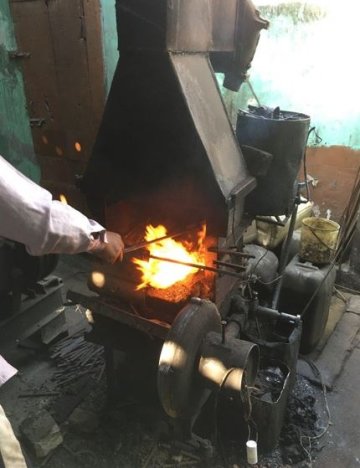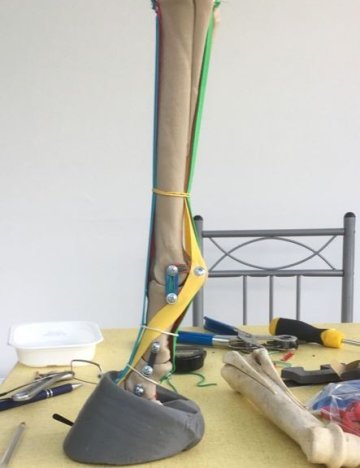A journey through Brooke’s Global Farriery Project
This year, Brooke’s Global Farriery Project has gone from strength to strength, with a new focus on shoemaking. Global Farriery Advisor Angus Wiseman takes a journey around our country programmes and gives us an update on what’s been happening.
Stop 1 - Ethiopia
Our main focus here right now is to introduce steel shoes to farriers and encourage a move away from rubber shoes, to reduce the amount of welfare problems that are caused by their use. At the moment, we’re working with a small group of farriers to build up competency, but the hope is that they will get to a level where they feel safe to apply steel shoes without supervision and be able to pass their knowledge on. One of our external farriery consultants visited this group in June, before I followed up again in November.
Stop 2 - Pakistan
Excitingly, Brooke Pakistan is currently working on a potential farriery training centre at the University of Narowal, Punjab. In September, we were pleased to send one of our external farriery consultants to the university to give a presentation on hoof care. On that same trip, another of our external consultants gave simultaneous training to farriers and shoemakers in Lahore. This was the first farriery visit where we have included shoemakers, as it is crucial that we have their involvement to try and improve the quality and standard of the shoes that they produce, to make them easier for the farriers to fit.
Stop 3 - Senegal
Also in September, myself and an external farriery consultant spent two weeks in Senegal working with a cohort of 13 farriers at the Vocational Training Centre, with a strong focus on tool making, shoemaking and shoe fitting. All these components are crucial as they link from one to the next. If we can’t produce good quality tools, we’re not going to produce good quality shoes. If we’re not producing good quality shoes then they won’t fit well to the animal’s foot and the animal will suffer.
During this trip, we were extremely fortunate to have Abdurazak Bamud, the farriery focal point from Brooke Ethiopia, join us. I think linking farriery focal points together, getting them to see the different contexts is invaluable in moving the Global Farriery Project forward. This is a picture of Abdi being presented with a certificate from Aissatou, who is the Brooke West Africa focal point. It seemed to be that they had quite a lot of collaboration between themselves, discussing their roles.
Stop 4 - India

In October, I visited India with a colleague from the Brooke Animal Health team. On previous visits, we’d noted that shoes are one of the big issues that are causing welfare problems for horses, so we visited a variety of shoemakers. These images are from a small unit where they mass produce shoes using machines. It’s a very fast process where they’re producing around 150-200kg of shoes a day, which are sold to local farriers. It’s important that we work with these people as they’ve got quite a large reach, being a main supplier. We discussed the elements of well-made shoes, whether he can change the type of material he uses but everything comes down to money and demand, so this going to be very much an ongoing thing moving forward.
We also visited smaller shoemakers. This is the second time I’ve visited this gentleman, he is a shoemaker and farrier. He produces shoes that he sells on a less wide scale but he also uses he shoes that makes himself. He’s an incredibly inventive chap, he’s put these machines together to help him with the shoemaking process, make it a little less labour intensive, although there’s still room for development in the quality of his shoes. But the kind of person he is, working with him, we will see change happen.
We also worked with a couple of individual shoemakers/farriers. They make shoes for themselves to put on.
The chap on the left of the screen has been a farrier/shoemaker for 40 years, the one on the right has been a farrier/shoemaker for 4 months. I think regard to facilitating and implementing change in the quality of shoes we see and the practice they have in applying them, I think we’ve got a greater chance of developing change in the chap on the right as he’s new to it and doesn’t have 40 years of ingrained habits to change. So by focussing our target audience we may be able to help with the progression of shoemaking and farriery skills.
During this visit we also visited the Flying Anvil Foundation in Dundlod, Rajasthan. This is an institution that was founded by a Swiss farrier, Bernard Duvernay. He’s provided training for several years now to farriers in India, but targeting the more lucrative sports/leisure horse market. Now, he’s providing training for farriers of working equids on behalf of Brooke India, so we stopped by the training to see what they were up to. I was personally very impressed with the whole set up. Bernard and his staff are very thorough in what they teach, they keep it to a basic level and for me that’s important because if we overlook the basics initially, things get lost along the way.
This relationship is really exciting and I hope we can build on it.
What else is new?
Farriery pocket books
I’m pleased to say that we now have farriery pocket books which are filled with instructional pictures rather than words. This means that we can hand them out to all local farriers as being literate is not a requirement.

So far, the feedback has been very positive. Hopefully it’s a tool that help them improve in the quality of the work they do and in communicating what quality work is to the horse owner, who is the end user and pays the bills.
Teaching models
We’ve also been developing model legs and feet to help with teaching. We are getting this rolled out across country programmes in limited numbers as its quite a slow production process - 3D printing the bones for a single leg takes 10 hours, printing a single hoof capsule takes eight hours.
